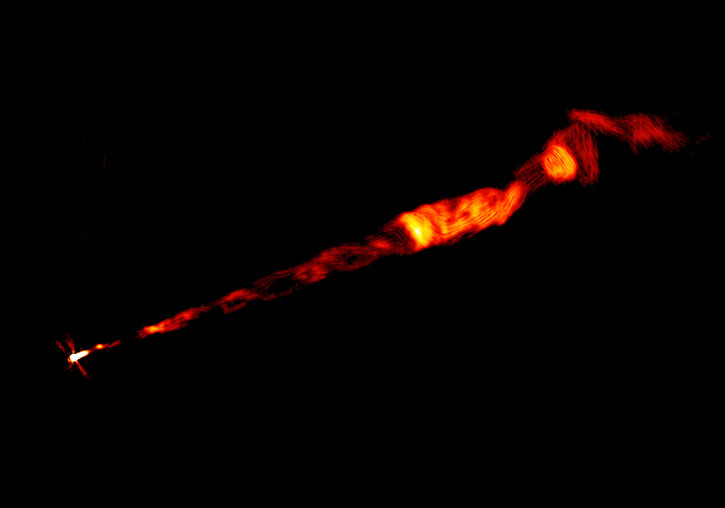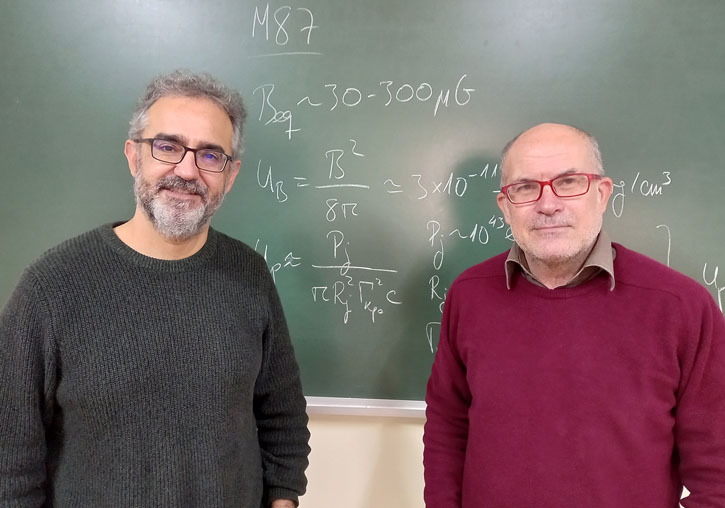Valencian astrophysicists reveal the nature of the double helix observed in the energy jet of the galaxy M87
- Scientific Culture and Innovation Unit
- December 7th, 2021

A group of astrophysicists including two professors from the University of Valencia, José María Martí and Manel Perucho, published today in the prestigious Astrophysical Journal Letters an image of the jet of the galaxy M87 in which it is shown that the plasma of the jet it is configured in two large bright helixes in radio frequencies of almost 3,300 light-years from the supermassive black hole at the centre of the galaxy.
This image shows the configuration of the magnetic field along the jet to distances far greater than those known so far in any extragalactic jet. “This field is, on the one hand, responsible for the formation of the jet around the black hole and, on the other one, fundamental for its evolution and for the generation of radiation in the jet”, comment professors Martí and Perucho, also members of the Department of Astronomy and Astrophysics, and the Astronomical Observatory of the University of Valencia.
M87 is an elliptical galaxy located 55 million light-years from Earth. At its centre is a supermassive black hole with a mass of 6.5 billion solar masses. This black hole is the first to be observed by the Event Horizon Telescope (EHT) in 2019.
The team led by the Italian astrophysicist Alice Pasetto (Autonomous University of Mexico) has obtained high quality images at different frequencies in radio waves with the interferometric device VLA (National Radio Astronomical Observatory, Socorro, USA), a fact that has allowed to reveal this three-dimensional structure of the jet’s magnetic field. “The field and the brightest part of the jet is structured in a double helix, similar to the DNA structure”, says Pasetto.
A few months ago, new EHT images showed the structure of the field very close to the black hole, in a study led by UV researcher Iván Martí-Vidal. In this new work, Pasetto and her colleagues have used VLA radio telescopes to study the structure of the field and the dynamics of the jet far away from the black hole. “The magnetic field is expected to have a helical structure very close to the black hole, and to play a fundamental role in the channelling and acceleration of the plasma, but we did not expect such an orderly field at such big distances”, says José María Martí.
“It is foreseeable that the field will weaken with distance due to different processes such as the investment of magnetic energy in the acceleration of the particles”, adds Manel Perucho. In addition, the development of waves that grow in amplitude along the jet may contribute to order it, say the Valencian researchers. Thus, the field would be compressed in regions where the pressure is higher. This interaction would be precisely responsible for generating the double helix structure.
This fact could be occurring in similar scenarios in other galaxies in the Universe, they conclude. “M87 is relatively close to us, which allows us to study it in greater detail and helps us understand more distant scenarios”, says Martí.
Article: Pasetto et al. «Reading M87ʼs DNA: A Double Helix Revealing a Large-scale Helical Magnetic Field». The Astrophysical Journal Letters, 923:L5 (10pp), 2021 December 10 https://doi.org/10.3847/2041-8213/ac3a88
Photo captions:
- (From left to right) Manel Perucho and José María Martí.
- VLA image of the M87 radio jet, made at multiple radio frequencies. The jet seen in this image is about 8,000 light-years long. This image clearly shows the corkscrew-like helical structure in the inner part of the jet, which originates at the bright spot at the left, at the core of the galaxy, where a supermassive black hole resides. CREDIT: Passeto et al., Sophia Dagnello, NRAO/AUI/NSF.
















